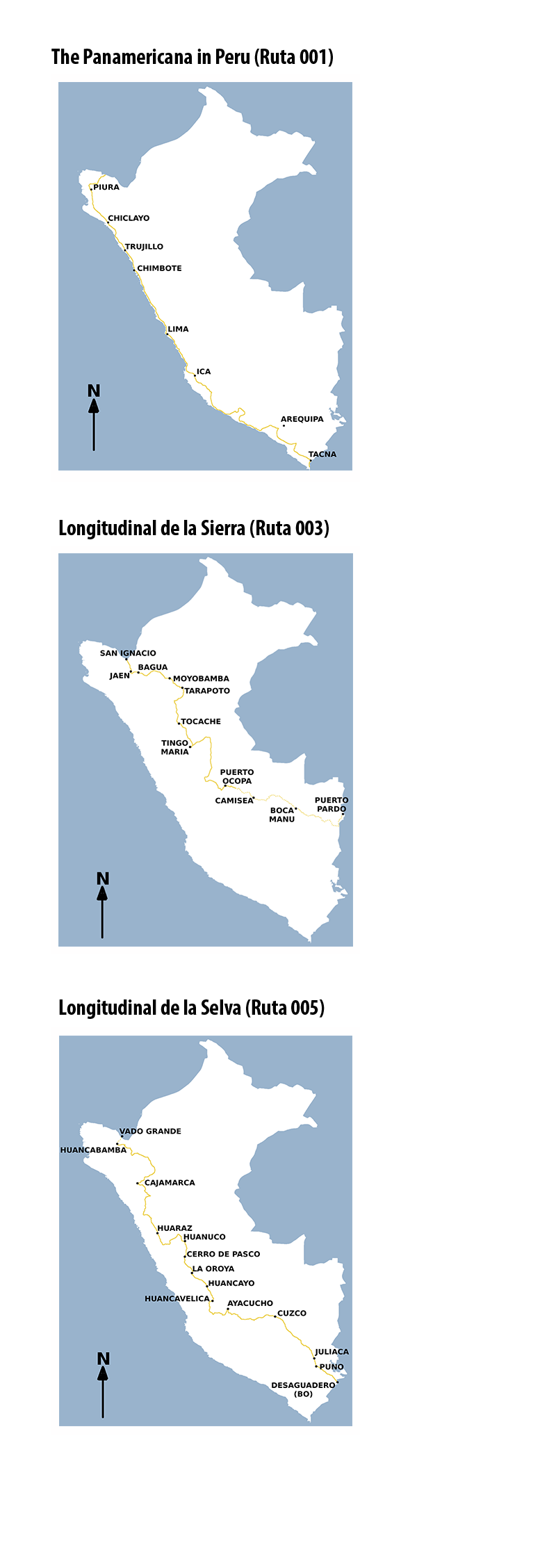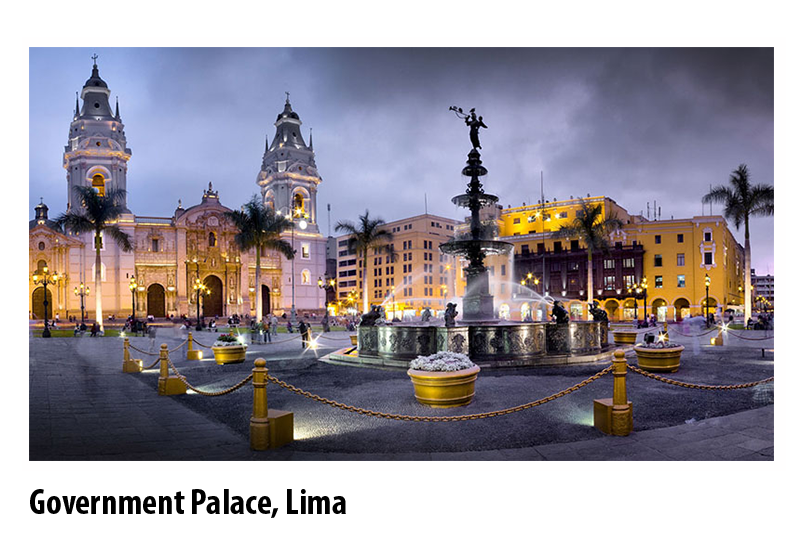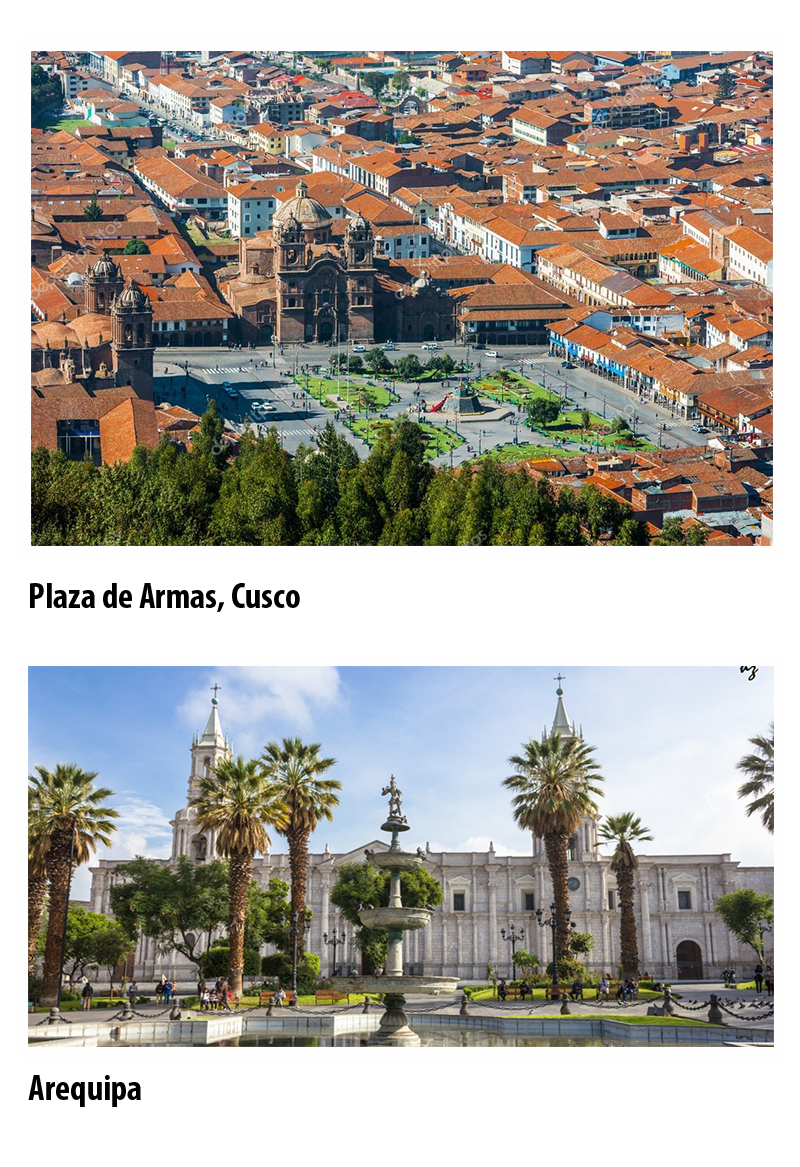There are three major longitudinal (north to south) highways in Peru, each corresponding to one of Perus three geographic regions. The Panamericana runs along the western coastal strip, the Longitudinal de la Sierra runs through the Andean highlands, and the Marginal de la Selva heads roughly north to south through the high jungle in the east.
Perus three longitudinal highways are designated with odd numbers, while the 20 transverse highways (west to east) are numbered evenly. Subsections and branch roads are designated with additional letters (for example, 001N and 001A, both of which form part of the Panamericana).
The Panamericana in Peru (Ruta 001):
The Pan-American Highway is a road network stretching from Prudhoe Bay, Alaska, to Ushuaia in Argentina. Measuring approximately 30,000 miles (48,000 km), it runs through North America, Central America, and South America in an almost unbroken chain (the Darien Gap between Panama and Colombia being the most notable break in the network).
The Peruvian stretch of the Pan-American Highway is called the Panamericana or Carretera Longitudinal de la Costa (Longitudinal Coastal Highway). It stretches for about 1,500 miles (2,414 km) along the coastal strip of Peru, running from the Ecuadorian border in the north to Chile in the south.
The highway is divided into two main sections, the Panamericana Norte (North) and the Panamericana Sur (South). Both sections officially begin in Santa Anita in the Ate province of Lima (at a point on the highway known as kilometer zero, or Km.0+000).
The two sections of the Carretera Longitudinal de la Costa connect many of Perus major cities. The Panamericana Norte (001N) heads from Lima along the north coast of Peru, passing through important cities such as Chimbote, Trujillo, Chiclayo, and Piura before heading inland to the Peru-Ecuador border-crossing at La Tina. One of the Panamericana Norte three branch roads -- the 001A -- heads back to the coast via Sullana to Talara, Mancora and onto Tumbes and the larger Peru-Ecuador border-crossing point.
The Panamericana Sur (001S) heads south from Lima, passing through Ica and Camana before heading further inland towards Arequipa. The highway then drops further south to Moquegua and Tacna and onto the Peru-Chile border at La Concordia. A branch road, the 001SA (also known as the costanera), hugs the coast as it passes through Camana, Mollendo, Ilo, Tacahuay and onto Tacna.
The Panamericana is completely paved with no missing or impassable sections (unlike the Longitudinal de la Sierra and the Marginal de la Selva). For travelers -- especially those traveling in Peru by bus (or hitchhiking, perhaps) -- it offers reasonably straightforward overland connections between all of the major cities located on Perus coastal strip.
Longitudinal de la Sierra (Ruta 003):
The Carretera Longitudinal de la Sierra (Longitudinal Highland/Mountain Highway, Ruta 003) runs north to south for approximately 2,240 miles (3,600 km) from Vado Grande on the Ecuadorian border to Desaguadero on the Peru-Bolivia border.
The highway is also known as the Caminos del Inca (Inca Road) because it follows a similar route to the old Inca Royal Road, or Main Andean Road, of the Qhapaq nan road network.
Like the Carretera Longitudinal de la Costa (Panamericana), the Longitudinal de la Sierra is divided into north and south (norte and sur) sections, designated with 003N and 003S respectively. The highways central point, or km 0, is located in the La Oroya district of the Junin region (central highlands).
The road connects many of the sierras most important cities, including (from north to south): Huancabamba, Cajamarca, Huaraz, Huanuco, Cerro de Pasco, Huancayo, Huancavelica, Ayacucho, Cusco, Juliaca, and Puno. Many stretches, however, are unpaved or still under construction (especially in rural areas), particularly in the central highlands and further north.
Longitudinal de la Selva (Ruta 005):
The third longitudinal highway in Peru is the Carretera Longitudinal de la Selva (Longitudinal Jungle Highway, designated as Route 005), also known as the Marginal de la Selva or Carretera Fernando Belaunde Terry. The highway runs predominantly through the selva alta (high jungle) regions of Peru.
The Longitudinal de la Selva should run all the way from the Puente La Balsa border-crossing point on the Peru-Ecuador border (near San Ignacio) to the Puerto Pardo/Rio Heath border point on the Peru-Bolivia border. As it stands, however, large sections of the jungle highway are unpaved, under construction or, in some cases, altogether nonexistent.
Like the longitudinal coastal and highland highways, the Longitudinal de la Selva is divided into two main sections: the Longitudinal de la Selva Norte (North) and the Longitudinal de la Selva Sur (South). The two sections meet at km 0 in the Chanchamayo Province in the Junin region.
The southern half of the road is particularly underdeveloped, especially from Camisea through to Manu and Puerto Pardo (Madre de Dios region).
The northern half of the highway provides a more viable overland route for travelers, connecting cities such as (from south to north) Tingo Maria, Tarapoto, Moyobamba, Bagua, Jaen and San Ignacio. The Tingo Maria to Tarapoto road still has a bad reputation, but an increase in paved sections in recent years has reduced both the travel time and instances of banditry along the route.


At press time, US$1 equals S/2.8. Frommer's lists exact prices in the local currency. The currency conversions quoted above were correct at press time. However, rates fluctuate, so before departing consult a currency exchange website such as www.oanda.com/convert/classic to check up-to-the-minute rates.
Peru's official currency is the nuevos sol (S/), divided into 100 centavos. Coins are issued in denominations of 5, 10, 20, and 50 centavos, and bank notes in denominations of 10, 20, 50, 100, and 200 soles. At press time, the rate of exchange had dipped to just under 3 soles to the U.S. dollar (from a high of about 3.5). The U.S. dollar is the second currency; many hotels post their rates in dollars, and plenty of shops, taxi drivers, restaurants, and hotels across Peru accept U.S. dollars for payment.
Note: Because many Peruvian hotels, tour operators, and transportation vendors charge prices solely in dollars, U.S. dollar rates are often listed in this guide.Peru's official currency is the nuevos sol (S/), divided into 100 centavos. Coins are issued in denominations of 5, 10, 20, and 50 centavos, and bank notes in denominations of 10, 20, 50, 100, and 200 soles. At press time, the rate of exchange had dipped to just under 3 soles to the U.S. dollar (from a high of about 3.5). The U.S. dollar is the second currency; many hotels post their rates in dollars, and plenty of shops, taxi drivers, restaurants, and hotels across Peru accept U.S. dollars for payment. Note: Because many Peruvian hotels, tour operators, and transportation vendors charge prices solely in dollars, U.S. dollar rates are often listed in this guide.

Passports
See www.frommers.com/planning for information on how to obtain a passport. For information, please contact the following agencies:
For Residents of Australia: Contact the Australian Passport Information Service at tel. 131-232, or visit the government website at www.passports.gov.au.
For Residents of Canada: Contact the central Passport Office, Department of Foreign Affairs and International Trade, Ottawa, ON K1A 0G3 (tel. 800/567-6868; www.ppt.gc.ca).
For Residents of Ireland: Contact the Passport Office, Setanta Centre, Molesworth Street, Dublin 2 (tel. 01/671-1633; www.irlgov.ie/iveagh).
For Residents of New Zealand: Contact the Passports Office at tel. 0800/225-050 in New Zealand, or 04/474-8100; or log on to www.passports.govt.nz.
For Residents of the United Kingdom: Visit your nearest passport office, major post office, or travel agency or contact the United Kingdom Identity & Passport Service at tel. 0870/521-0410 or search its website at www.ukpa.gov.uk.
For Residents of the United States: To find your regional passport office, either check the U.S. State Department website or call the National Passport Information Center toll-free number (tel. 877/487-2778) for automated information.
Visas
Citizens of the United States, Canada, Great Britain, South Africa, New Zealand, and Australia do not require visas to enter Peru as tourists -- only valid passports. Citizens of any of these countries conducting business or enrolled in formal educational programs in Peru do require visas; contact the embassy or consulate in your home country for more information.
Tourist (or landing) cards, distributed on arriving international flights or at border crossings, are good for stays of up to 90 days. Keep a copy of the tourist card for presentation upon departure from Peru. (If you lose it, you'll have to pay a $4 fine.) A maximum of three extensions, at 30 days each for a total of 180 days, is allowed.